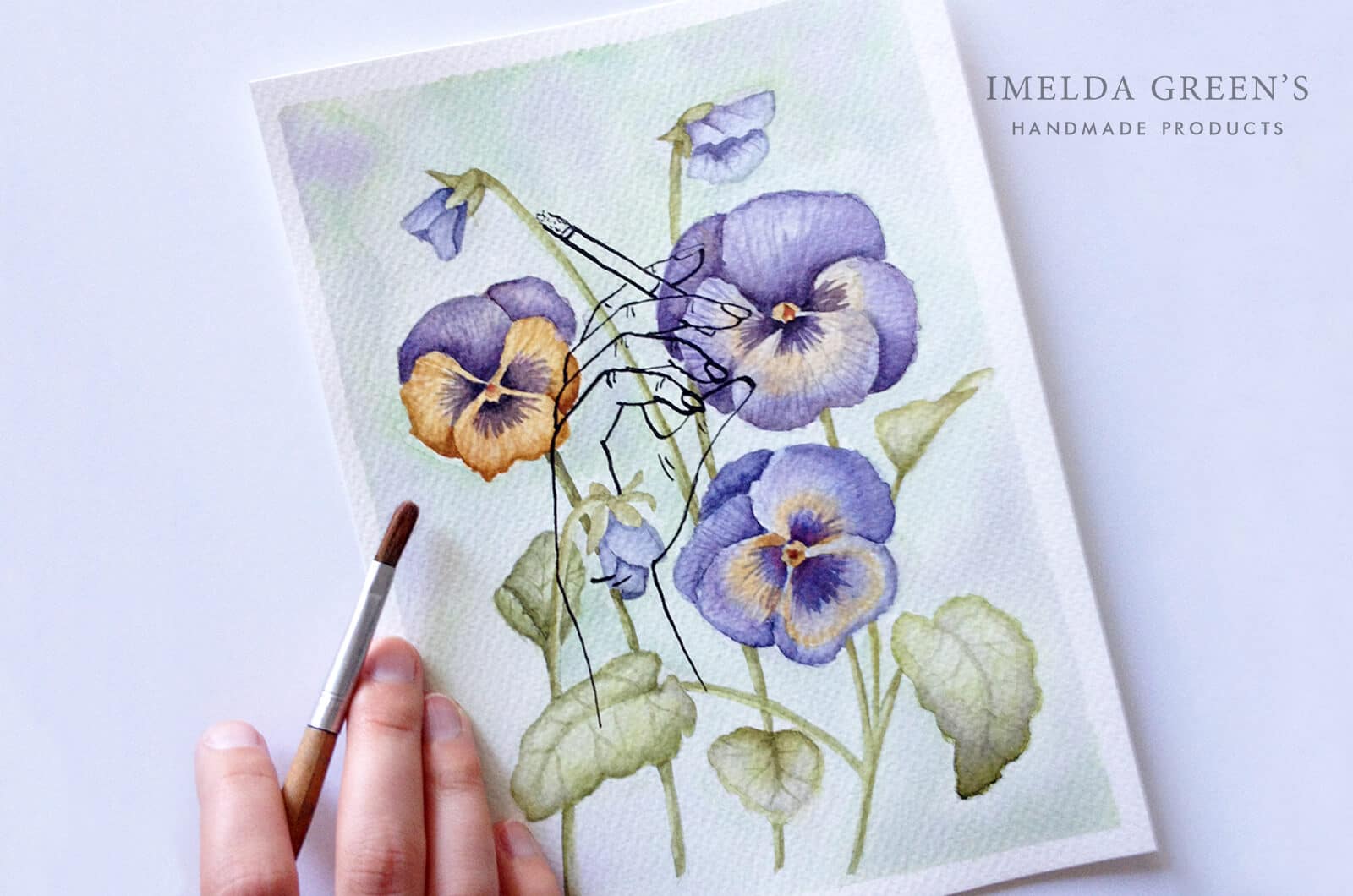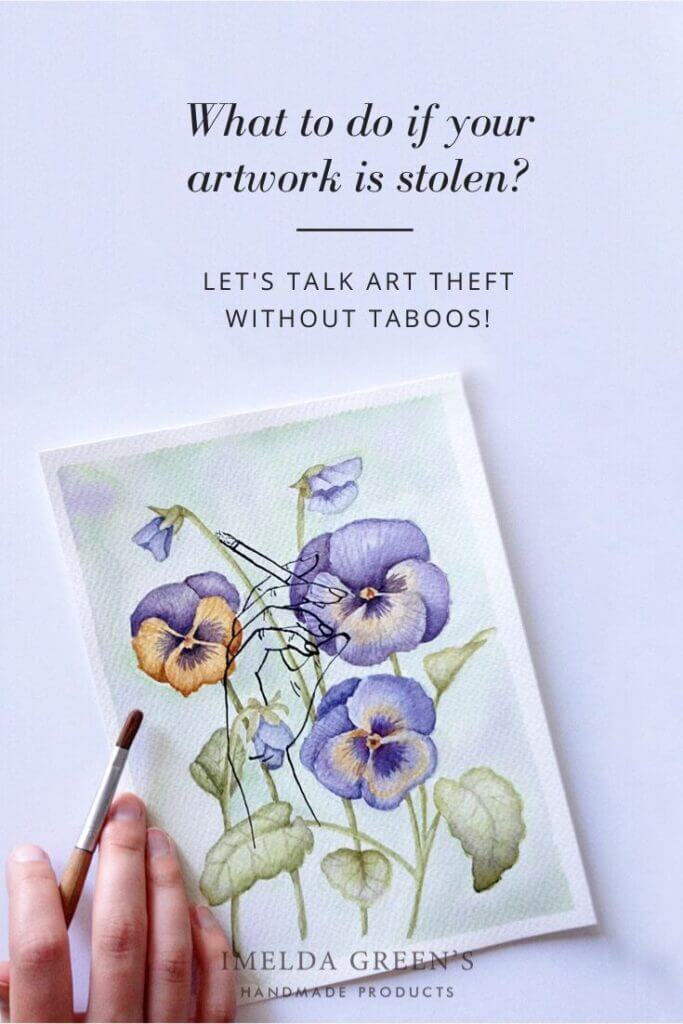
What to do if your artwork is stolen? – Let’s talk ART THEFT
Art theft is a super-relevant topic, which I have discussed a couple of weeks ago on this blog. In that post, I helped those who want to use copyrighted images for their projects and how they can do it legally, but today I want to explore the other side: what can you do if you don’t want to be the victim of art theft?
What is art theft?
In our context, art theft means using a piece of artwork (photo, illustration, etc.) for personal or commercial purposes without informing, and therefore impairing the artist. Using the artwork without the artist’s consent is considered theft regardless of whether the artist shared his work online, or if the artist is credited.
What should you know about your intellectual property?
Everything that you make or create (and not copy!) is your intellectual property, and the copyright belongs to you, without you requesting or petitioning for this right. If you post your artwork on your social media or website, it remains your property. If somebody uses it without informing you, he infringes the law. You could just shrug and walk away, saying ’it does not harm me.’ You are wrong. It’s not only you, whom these people harm (often financially) but the entire creative industry.
If somebody uses an image for free, that he should have paid for if he acted ethically, and often legally, then it’s not only your own work that is devalued, but also the work of every other creator. This is why it is so important to act if you meet art theft.
When is it illegal to use my intellectual property?
The answer is easy: in every case when your permission is not asked and you haven’t agreed to the terms of use, the use of your artwork is illegal.
Crediting you as the artist will not make image use legal. This seems to be a grey zone because many people think that if they credit the artist, it means free exposure for them. However, legally speaking, crediting the artist is not enough.
Crediting the artist means placing a clickable link under the image, that leads to the artist’s official website or chosen social media platform, so it should bring real value to the artist.
Whether the artist will claim his copyright when he is accurately credited is a personal choice. As a rule of thumbs, artists will often consent to the use of their work, when the artwork was taken for personal use and the image source is accurately linked – even though it is worth sending a message to the user and tell him to ask for permission next time.
If you can’t decide whether your work was taken for personal or commercial use, read this post.
When people/companies want to use your artwork for commercial use it is worth considering to charge an up front fee or royalties in exchange for the image. The amount you charge will depend on the profit your work will generate for the person/company.
How to avoid being the victim of art theft?
Your best chance is to act before your work has actually been stolen, so basically before you put it online. In our context, most artworks are stolen from the internet. You cannot fully prevent your work being stolen, but you can make the thief’s job harder, and hence dissuade him from acting.
A well-known way of protecting your work is placing a watermark on it. Depending on the way the thief wants to use your work, this can cause difficulty – especially if the person wants to present your work as his own. Watermarking can, of course, lower user experience, so many artists choose to place a little watermark at the corner of their piece. This is not a full-proof solution of course, but it is more than nothing.
Another useful way to protect yourself is by sharing your work in a lower resolution than the original. You need to find the golden route here, because too low a resolution will mean a bad quality image, which you do not want to share in your portfolio. However, if someone wants to use your work in print, a low resolution image will definitely put him off.
Instead of sharing the original illustrations, I personally post photos of my watercolours, which makes it more difficult for people to re-use the illustrations (even though they can still use the photos). In the rare cases when I share the original pieces, I place them on textured backgrounds instead of pure white, so the background cannot be removed with just one click.
One of my most important tips is to document the creative process if you can. Take photos of the different stages of your work, or film it on video if you can. If you end up in court, these can be used as proof that the artwork is indeed your intellectual property.
What to do if your artwork has been stolen?
Despite all your efforts, it can happen that your artwork is stolen. I understand that you are raging with fury, but the best thing to do first is to write a polite letter to the user and ask him to remove the content that violates copyright (you can actually send a link to this post). Unfortunatly (or not), many people who use copyrighted content will do so not so much out of malice, but out of ignorance.
If the user is cooperative, you can ask for the artwork to be removed, you can ask for credit, or in certain cases you can negotiate a contract where you disclose the terms of use (this is mostly relevant in the case of commercial use).
In the more difficult scenario, the user will not admit to stealing your work.
In this case, you can ask for help from other artists and your followers on social media. Spread the word that a certain company has stolen your work, ask your followers and your artist friends not to buy anything from this company and to share the information. This naming and shaming technique often puts companies off stealing artwork, because word of mouth is a seriously important factor for a business in the age of social media.
As a last resort, you should let the user know that if he does not remove copyrighted content, you will take legal steps to resolve the issue. You should also mention that you have proof of the artwork being your own intellectual property (if you do have proof). This does not necessarily mean that you need to really sue, but it is worth letting the infringer know that you take this seriously.
What NOT to do if your artwork has been stolen?
There is one very important thing: don’t stay silent and don’t apologize for being angry. Your outrage is fair, this is your job. A chef works with his knife, you work with your creativity. If the knife is stolen, everyone understands what the outrage is about. If the product of your creativity is stolen, it is the same thing. If someone does not agree, you are welcome to show him this piece of writing. Yes, if you post your work online, you take a certain risk that it will be stolen, but the artwork remains your own intellectual property.
Don’t move on when you hear other artists’ work being stolen! It is in our best interest as artists to stop art theft all together. If you come across art theft and you have a social media profile, share the information with your followers and stand up for artists’ rights.
You should not steal either!
It is perhaps less obvious, but if you are an artist / illustrator who uses reference images, and the photos you paint from are subject to copyright, you cannot use them freely. Even though the illustration itself is a new piece of work, as long as the original reference photo is recognizable, you are violating copyright. The same thing applies if you copy another artist’s work. This is a very useful video about reference images and how to use them legally.
Has your artwork ever been stolen? What have you done or what would you do if it happened? Share your experience in the comments below!



Comments (4)
Kellie Espie
March 1, 2023 at 2:48 am
This was very helpful. Thank you so much for posting it!
Imelda
March 16, 2023 at 9:54 pm
Thank you Kellie!
Ethan
November 28, 2023 at 5:23 am
What a brand stole my art and already sold many clothing items
how much money am I entitled to
Imelda
November 29, 2023 at 10:44 am
I’d say that depends on how much money they made out of your art, which you could maybe estimate from the items’ prices. Of course, actual numbers sold are probably confidential information and you can only get at those with the help of a lawyer, but an indication could be the brand’s number of followers maybe.